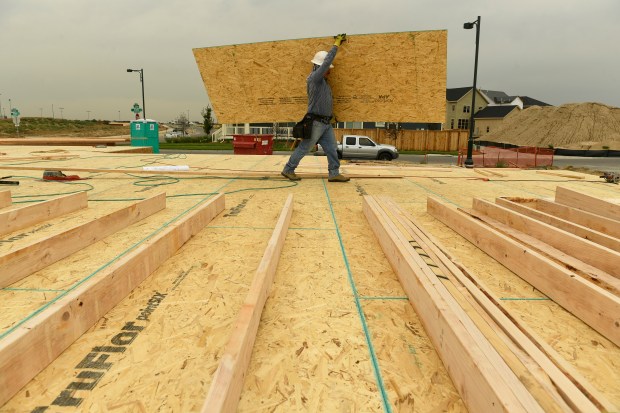Homes will soon rise in Stapleton’s 12th and final neighborhood, marking the beginning of the end of a two-decade boom for single-family home construction in Denver.
Developer Forest City is about to release the first of 1,300 single-family lots just south of the Rocky Mountain Arsenal National Wildlife Refuge on land that once hosted the northern runways of Stapleton International Airport.
Workers with heavy equipment have been busy grading dirt, putting in roads and installing water and sewer infrastructure on land north of 56th Avenue, west of Havana street and east of Dallas Street.
A construction wave that started with Stapleton’s South End neighborhood in 2001 will bookend with the North End neighborhood. Once the last home on the last street is sold, probably some time in 2021, only commercial lots will be left.
“Depending on the strength of the demand for market-rate housing, North End could be built out in approximately three years,” predicted Forest City Stapleton spokesman Tom Gleason.
Lowry, a redeveloped military base south of Stapleton, is selling out its last few new homes. Green Valley Ranch to the north has a couple of hundred more lots available within Denver boundaries than Stapleton does, but completion there, too, is a matter of time.
“We have somewhere in the neighborhood of 1,500 homes that we have yet to build on the Denver side,” said Pat Hamill, chairman and CEO of Oakwood Homes, the builder behind Green Valley Ranch.
But those homes, which target families looking for a lower price point, will probably be gone within three to five years, he estimates.
Metro Denver has other communities in surrounding counties with a lot of land to build on. But for those who want a new detached home in the city of Denver, the clock is ticking.

“That Denver address is important. It is part of the brand,” Hamill said.
Denver might in the distant future add more new homes around Denver International Airport. But even in that area, known as the Aerotropolis, Aurora is expected to grab the lion’s share of new homes.
Redevelopment plans for the areas around the old Gates Rubber Factory and the Elitch Gardens amusement park and Pepsi Center are likely to be dominated by apartments and attached housing.
“Within Denver, we are running out of single-family lots after that Stapleton piece,” said Keely Maher, research manager at Metrostudy in Denver.
Forrest Hancock, development manager at Stapleton, puts it another way. Scrapes and infill projects will be about the only way to buy a new stand-alone home in Denver in the not-so-distant future.
Courtland Hyser, principal planner with the City of Denver, disputes assertions that Denver won’t see new single-family housing construction again.
“Beyond what has come in for permits, there is all this land sitting out there that could be future single-family development,” Hyser said of tracts on the city’s northeastern corner near Denver International Airport.
It could takes years, however, before that land is permitted and developed, leaving a gap. He acknowledges that Stapleton and Lowry provided an opportunity that core cities blocked in by suburbs don’t often get.
“For an older and established city like Denver, it is unique to have undeveloped land outside of town where you can build single-family neighborhoods,” he said.
Hyser argues that Denver doesn’t need another Stapleton to survive and move forward. Denver is full of single-family neighborhoods that will draw in new families and keep things vibrant.
“It is not crucial for the future. We can be successful without having that,” he said.
Colorado voters in 1974 passed a constitutional amendment that required counties to get voter approval to annex land. The Poundstone Amendment directly targeted Denver, which is both a city and county, and limited its ability to expand.
Denver County’s population reached 493,887 in the 1960 Census. By 1990, it had shrunk to 467,610. Over the same time, the population of the larger larger metro Denver area nearly doubled from 934,199 to 1.8 million.

The relocation of Stapleton’s operations in 1994 to a new airport on ground Adams County provided Denver another chance to grow. It freed up 4,700 acres for redevelopment, and Denver chose to use that land primarily for new residential neighborhoods.
Denver’s population is now above 700,000. Stapleton alone has added more than 27,000 residents to that total and will contribute another 3,000 to 8,000 when North End and the Beeler Park neighborhood to the west are completed.
Last year, Forest City Stapleton ranked as the 10th most popular master-planned community in terms of sales in the entire country. No other new-home community in Colorado has come close to matching it in recent years.
Hancock boasts the North End neighborhood will have the best views available in Stapleton. Buyers who pick homes with a higher elevation will have views of the Front Range and downtown Denver if they face west.
Those facing to the north and east will have views into the wildlife refuge and the fields of Dick’s Sporting Good Park and the surrounding open space.
KB Home, Wonderland Homes, Parkwood Homes, David Weekley Homes, Thrive Home Builders, Infinity Home, Creekstone Homes, Lennar and Boulder Creek Neighborhoods will provide homes that range from $330,000 to $1.2 million.

That lower price is for Wee-Cottages from Boulder Creek. The two-bedroom model is 896 square feet with no basement. The homes are energy-efficient and priced low enough so people who don’t qualify for the 10 percent of homes that are designated as affordable can buy in.
Related Articles
-
Denver council orders new protections for renters who pay using vouchers or unconventional sources of income
-
Metro Denver home sales slow in July
-
“Denveright” plans chart out new direction for rapidly expanding Denver’s transit, parks over two decades
-
Sunday, Aug. 5, 2018 letters: Clean cars, guns, Walker Stapleton, sidewalks, injection sites, “purple drought,” rent control
-
Caldara: Does the city really want to lower rents?
Interstate 70 divides the seven neighborhoods on the south side of Stapleton from the five to the north. Forest City had more flexibility to design roads, parks and the landscape on the north side, which was less tied into Denver’s linear road grid.
The designs that will be available in the North End are similar to those now being constructed in Beeler Park. But the new urbanism practice of mixing homes of different styles from different builders near each other will continue.
Hancock said that the Southwestern and Mediterranean models found on the south side of Stapleton weren’t brought into the north, which has more mid-century and prairie architecture.
He said Forest City is about to release lots to builders any day, which will allow them to start digging basements.
Once Stapleton wraps up, Forest City, which has shifted its focus entirely to commercial development, will be done building residential communities, Hancock said.


